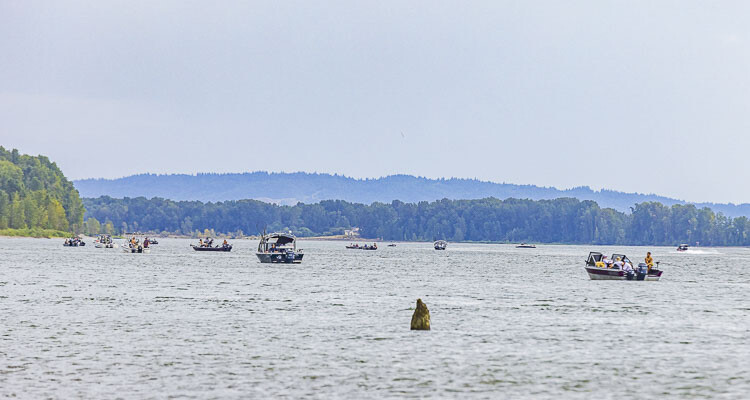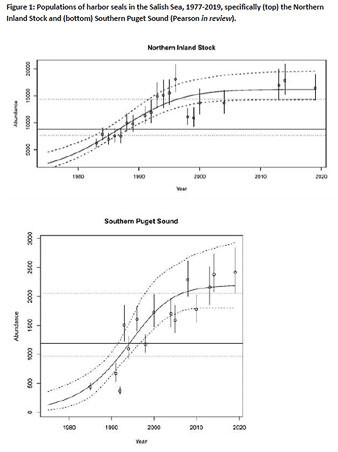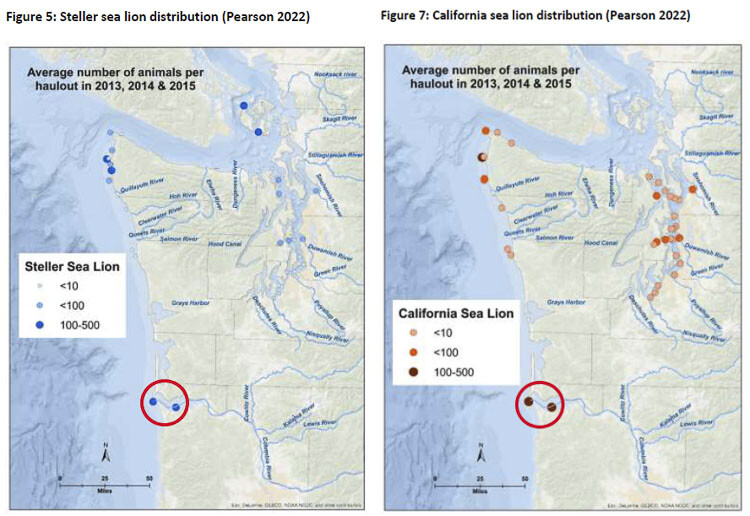
Some of the largest concentrations of sea lions are at the mouth of the Columbia, intercepting salmon as they travel to the ocean, or back to the Columbia and Snake rivers to spawn
Todd Myers
Washington Policy Center

As politicians look to spend hundreds of millions of taxpayer dollars to recover salmon or billions to destroy dams, the Washington State Academy of Sciences (WSAS) suggests that reducing the population of seals and sea lions could be an effective and low-cost way to increase salmon runs in the near term.
The number of Chinook salmon eaten by seals and sea lions “is substantial and has increased steadily” according to an analysis by WSAS researchers released last month. The report says that while we don’t know exactly how significant the impact of predation from seals and sea lions (known as “pinnipeds”), the authors recommend the state experiment with reducing their population.

The legislature asked the Academy of Sciences to “to review and evaluate research needed to determine the extent of pinniped predation on Chinook salmon in Puget Sound and Washington’s outer coast…” Scientists and others working on salmon recovery have long known that pinnipeds were a threat to salmon and steelhead across the state. This research is an effort to gauge how much of a threat.
Due to the protections in the Marine Mammal Protection Act (MMPA), the population of seals and sea lions has increased significantly over the last five decades. The report notes that populations may actually be higher now than in the past “due to indigenous harvest.” As the population of pinnipeds increased, so did the predation on salmon and steelhead.
Report authors note that survival rates of salmon and steelhead are lower in the Puget Sound than on the coast, where they face fewer threats from seals and sea lions and appear to have declined since the 1970s. “Although several causes of this decline, including reduced prey availability to disease (Pearsall et al. 2021) are plausible,” the authors wrote, “pinniped predation is considered a primary driver of increasing mortality rates..” This predation can be particularly important, and “even minimal predation can strongly impact salmonid stocks.” One study found that harbor seals accounted for 90 percent of the mortality of steelhead smolts in the Nisqually estuary in South Puget Sound.
The impact is not only in the Puget Sound, but on the coast and particularly at the mouth of the Columbia River. Some of the largest concentrations of both California and Steller sea lions are at the mouth of the Columbia, intercepting salmon as they travel to the ocean, or back to the Columbia and Snake rivers to spawn. Predation at these locations can be even more impactful because “Pinnipeds that use river mouths, estuaries, and upriver habitats are more likely to be specialists in predating on salmon than those that forage in open-ocean habitats.”

The report recommends the state begin experimenting with culling seals and sea lions at key locations. This would likely require changes to the MMPA. The report notes that culling is difficult because “the MMPA also requires proof that non-lethal harassment does not work, which is challenging to prove in most marine systems.” Alternatives, such as using noise to harass seals and sea lions, have been unsuccessful.
With pinniped populations at such a high level, reducing seal and sea lion populations would be a low-risk strategy. “Given that Washington pinniped populations are all at high abundance,” they wrote, “any lethal removal except on a massive scale would seem to pose little to no risk to the viability of the pinnipeds.” Even small benefits would be meaningful and “the risk of not conducting experiments whose results can inform management actions is high. The major risks of lethal removals appear largely social and political, rather than risks to pinniped populations as a whole.”
Reducing pinniped populations would also provide the opportunity for experimentation, helping determine the best ways to reduce predation.
Finally, it would be a relatively low-cost strategy that could yield meaningful increases in salmon populations. So much of the focus on salmon recovery is on dramatic, high-cost projects like destroying the Snake River dams, or large restoration projects. Some of these are certainly worthwhile, and we have advocated for increased funding for effective recovery efforts. But it makes little sense to refuse to take effective and low-cost steps like reducing pinniped populations while advocating for spending tens of millions on habitat restoration, or tens of billions on destroying dams.
Todd Myers is the director of the Center for the Environment at the Washington Policy Center.
Also read:
- POLL: Should the Clark County Clerk remain an elected position?Following public opposition, Clark County Council dropped a proposal to make the clerk an appointed role. Readers can now weigh in through this week’s poll on whether the clerk should remain elected.
- Opinion: Neighbors for a Better Crossing calls for a current seismic study for $7.5 Billion Interstate Bridge projectNeighbors for a Better Crossing is urging a new seismic study before construction proceeds on the $7.5 billion IBR project, raising transparency concerns and proposing an immersed tube tunnel alternative.
- Opinion: Washington’s Supreme Court hides the ball on state employee compensation offersJason Mercier criticizes the Washington Supreme Court’s decision to uphold secrecy in public employee compensation talks, calling for transparency reforms and public accountability.
- Letter: The Charterist III — Concerning the powers of the Legislative BranchJohn Jay continues his Charterist series, arguing that Clark County’s legislative branch is structurally weak and lacks the resources to balance the executive, calling for reform in the next charter review.
- Opinion: ‘Today’s Democratic Party is not our father’s Democratic Party’Editor Ken Vance reflects on how today’s Democratic Party diverges from the values he associates with his father’s generation, citing issues like taxation, gender policies, and shifting ideology in Washington state politics.











What a bunch of over book educated morons. Stop the use of pesticides, forest destruction, water pollution, fire retardants and human over fishing. Look in the mirror for all our problems.
One more thing. Why isn’t overflow of raw sewage overflowing by the millions of gallons every day into our rivers and oceans on your radar as a problem. And the fluoride poisoning everything. Everything is sealions fault, what a joke. Ignorance is bliss they say.